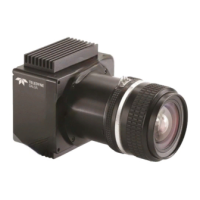43 Piranha 2 User’s Manual
03-032-00493-14 Teledyne DALSA
4
Optical, Mechanical, and
Thermal Considerations
4.1 Mechanical Interface
The camera’s electronics are housed in a rugged ized lightweight alu m inu m case.
Mounting
The camera can be mounted using the M3 holes (metric-threaded) on its base or top, and
on its front plate at the corners.
Environment
The camera and cables should be shielded from environmental noise sources for best
operation. The camera should also be kept as cool as possible. The specified operating
temperature is 10–50°C measured at the front plate, (the corresponding ambient
temperature range with still air is 0°C to 37°C). Mounting holes (refer above) allow you to
attach heat sinking.
Thermal Management
For any CCD camera optimal performance is achieved by transferring heat away from the
sensor. Keeping a sensor ―cool‖ red u ces the am ou nt of dark current ge nerated. Dark
current is the leading contributor to FPN, PRNU, dark offset, random noise and other
performance specifications, especially when a camera is significantly gained (i.e. +10db).
Generally, dark current doubles for every 7°C increase in temperature at the sensor and
increases linearly with integration time. Further variations in dark current cannot be
compensated for with our flat-field correction algorithms. For this reason, at high gains
(+10dB), high temperatures (40°C front plate), and low line rates, it is recommended that
you recalibrate the flat-field coefficients when the temperature shifts by ±10°C.
Note: Upon initial power-up the front plate camera temperature is near ambient. It is
recommended to perform flat-field correction once the camera gets within 10°C of its
steady state temperature. For Piranha 2, at an ambient temperature of 25°C and with no
airflow, the camera takes 90 minutes to achieve steady state and 20 minutes to reach
within 10°C of steady state. If your system cannot perform flat-field correction after
warm-up consider the recommended methods of reducing dark current and overall
camera temperatures (see below).

